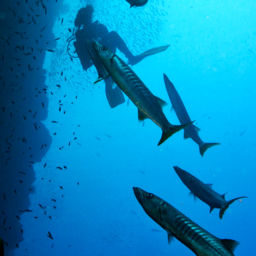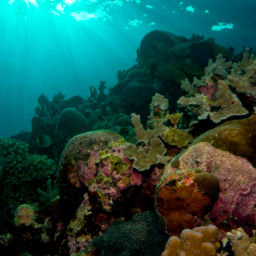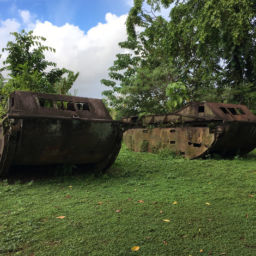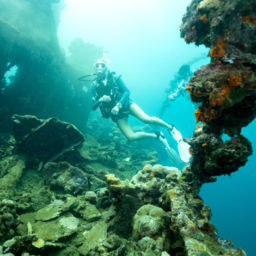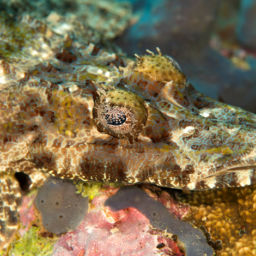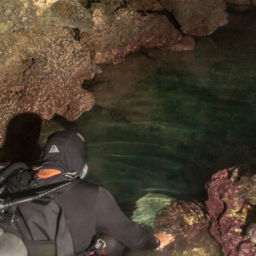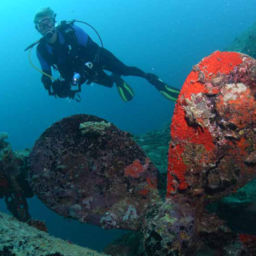What do you like to see when you dive? Big stuff? Macro? Pretty reefs? Or is it wrecks? Before I visited Munda in the Solomon Islands, I would not have called myself a wreck diver. I think of wrecks as dark, rusting constructions devoid of life. They’re interesting to history buffs or divers who like to push limits — or so I thought. Diving Munda wrecks and reefs changed these preconceptions.
Like much of the Solomon Islands, Munda is a tropical paradise; a lush, green island surrounded by turquoise lagoons and coral reefs. But the legacy of WWII is never far away, present above and below water. This is true nowhere perhaps more so than in Munda. Here there are reefs and wrecks. And the wrecks, just like the reefs, are teeming with life.
Diving Munda wrecks and reefs
I came to the Solomon Islands for its incredible marine biodiversity. I’ve dived here before and had a small taste of its busy coral reefs, which left me hungry for more.
The Solomon Islands sit on the eastern edge of the Coral Triangle, the global epicenter of marine biodiversity. It’s therefore unsurprising that dives here are fantastic. This area spans over 2.3 million square miles (6 million square km), encompassing Indonesia, Malaysia, the Philippines, Timor and Papua New Guinea. An astonishing 76 percent of the world’s coral species live here, along with six of the world’s seven turtle species and over 2,228 species of fish. On my first plunge into Rendova Lagoon it seems like they’re all here right now in Munda. I don’t know where to look first.
The reef wall at Shark Point, our first dive, is covered in corals of all shapes, sizes and colors. Soft corals, whips and sea fans make way for hard, branching corals and moon-shaped brain corals. Flitting among them are thousands of butterflyfish, damsels, angels, anthias and surgeons. Anemones stand by with their resident anemone fish on guard. Finally, out in the blue big schools of snapper, bluefin trevally and barracuda circle.
Our second dive at nearby Munda Reef offers a similar scene. This time a few reef sharks also join us along with some blue-spotted rays. Huge schools of scissortails and fusiliers whoosh past between us.
Wreck diving in Munda
If it were up to me, I’d come back to these same two dive sites every day for the duration of our stay, but our guides from Dive Munda have different ideas.
First, we visit Haipi Reef, about a 30-minute boat ride away. The variety of corals here equals the variety of reef fish. A few humphead parrotfish join us for the dive and we share our safety stop with huge schools of butterflyfish and damsels.
When we surface, our guides tell us our next two dives are wrecks. Consequently I’m not thrilled, but since I’ve enjoyed every dive so far, I’m not expecting to be disappointed. It’s these two dives that change my mind about wrecks.
The wrecks are both American fighter aircraft, the first a Bell P-39 Airacobra. This was one of the principal American fighter craft in service when the United States entered WWII.
It’s sitting on a white, sandy bottom and it’s mostly intact. But that’s not the first thing I notice — what I notice first is that I almost can’t see it for all the fish.
Large schools of juvenile fish surround the plane, and when I get close enough, I see it’s full of them as well, along with hundreds of colorful shrimp. The body of the plane, what I assume was once painted a drab gray, is now painted in colorful corals which create gorgeous patterns along the length of the plane.
The second wreck is the Douglas SBD Dauntless, sitting on a sandy bottom in very shallow water. Soft and hard corals, teeming with life, cover the wreckage. Furthermore, this one has an interesting story.
Our dive guide tells us that he once took a retired American pilot diving here, the very same pilot who was flying the plane when it was shot down. Furthermore, and even more remarkably, a short time later, the guide took a Japanese man diving here as well who claimed to have shot down the plane during the war.
According to our guide, the pair met up back in Honiara and have remained in touch. While I’m not sure how much of the tale is true, I began thinking about the stories and people behind the many other wrecks in the Solomon Islands. And, as a once disinterested wreck diver, Munda made a believer of me.
As of June 1, 2018, Solomon Airlines is offering non-stop roundtrip flights from Brisbane directly to Munda, making arrival and departure that much easier. Check the website for details.








